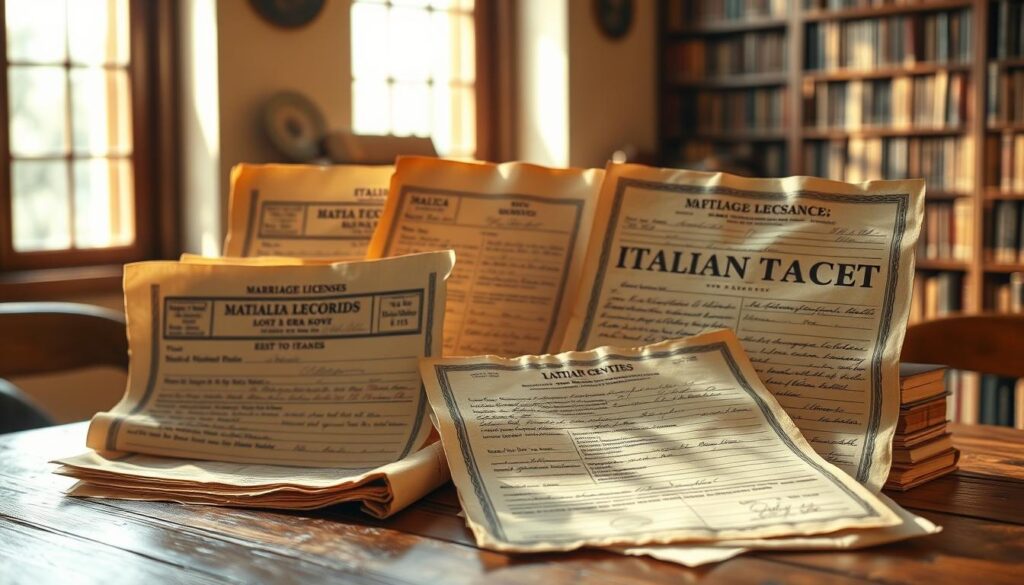Many Italian Americans feel connected to their heritage. They want to explore their family history. Uncovering your Italian roots can be rewarding and emotional.
Italian genealogy research helps you find relatives and connect with your past. You can piece together your family tree using records and resources. This journey deepens your understanding of your identity.
FamilySearch is the largest source of online Italian genealogy records. The Italians to America Passenger Data File (1855-1900) includes over 800,000 passenger records. These records contain valuable information about passengers from Italy.
Italian church records date back to the 1500s. They provide rich historical documentation for genealogical research. Comuni-Italiani offers information on all Italian municipalities.
The Portale Antenati gives access to civil registration and military records. Some records may not be digitized or indexed yet. Gathering information from living relatives is crucial.
U.S. records can help identify key details about your ancestors. Attending workshops on Italian genealogy can provide valuable guidance. Your Italian family history journey can be deeply rewarding.
Uncovering your ancestors’ stories connects you to your roots. It preserves your family legacy for future generations. With dedication and the right resources, you can find Italian relatives.
Understanding Italian Ancestry Research
Italian ancestry research requires knowledge of Italy’s structure and record-keeping practices. Italy has 20 regions and 110 provinces. Civil records are kept locally in town halls before moving to courts and archives.
Identifying your ancestors’ birth towns is crucial for your Italian heritage search. U.S. records and family knowledge can provide this information. Many Italian immigrants came from southern Italy and Sicily between 1876 and 1930.
Italian civil records fall into three categories based on time and location. These include Napoleonic, Restoration, and post-1866 Italian records. Records move from town halls to courts and archives after 70 years due to privacy rules.
“Genealogical research involves the study of various historical records and must be done step by step to accurately trace family history.”
Start your Italian ancestry research by gathering family information. Collect names, dates, and places related to your ancestry. This will form the base for exploring historical records in various archives.
Getting Started with Your Ancestry Search
Searching for Italian ancestors can be exciting and rewarding. Start by talking to older family members. They often have valuable information about your great-grandparents’ lives and origins.
Ask about birth villages, birth and death years, and immigration details. This info is crucial for building your Italian family tree.
“I never asked my grandmother about her parents, and now she’s gone.”
Many Italian Americans share this regret. It shows why talking to family is so important. One person found seven out of eight great-grandparents’ surnames just by asking relatives.
Knowing birth years and villages helps get vital records in Italy. Death years and villages can lead to death certificates. These documents often contain valuable info for your family tree search.
Every piece of information is important in uncovering your Italian heritage. Keep searching and you’ll soon uncover your family’s fascinating story.
Online Resources for Italian Ancestry
Finding Italian relatives through ancestry search is easier with online resources. Websites like Ancestry.com, FamilySearch.org, and Portale Antenati offer Italian genealogy records. These tools make your research more accessible and efficient.
These platforms provide access to passenger lists, civil registrations, and church records. Some databases are searchable by name. Others may need knowledge of your ancestors’ specific towns.
FamilySearch has increased access to Italian records thanks to volunteer indexers. It’s a valuable tool for Italian ancestry research.
The Antenati portal is the best resource for Italian research. It’s organized by province, civil registration period, town, record type, and year. This makes navigation intuitive and user-friendly.
FamilySearch’s interface may not be as streamlined as Antenati’s. However, it remains invaluable for Italian ancestry search.
“The Archivio di Stato di Napoli has maintained 22,000 passport and emigration files for individuals emigrating from Naples between 1888 and 1901.”
Not all Italian provinces have their records available online yet. Record availability may vary by location. Ancestry.com has less coverage of Italian records compared to other resources.
Many records still require browsing instead of searching. With patience and persistence, these online resources can reveal insights into your Italian family history.
Utilizing Italian Records
Italian genealogy records are key to uncovering your ancestors’ stories. Civil registration records provide essential information for building your family tree. These records are often available through online databases and state archives.
Catholic church records are another vital source for Italian genealogy research. They often predate civil registrations, sometimes going back to the 1500s. Parish directories can help locate these historical documents.

The Italian Catholic Church’s website is a valuable resource for finding ancestral records. These documents may contain details about your ancestors’ births, marriages, and deaths.
“The majority of Italian immigrants arrived in the U.S. between 1880 and 1920, settling in cities like New York, Boston, Philadelphia, Rhode Island, and Pittsburgh, often forming ‘Little Italy’ neighborhoods to preserve their cultural traditions and community ties.”
Multiple record searches are necessary for thorough ancestry research. Relying on a single document may not provide enough evidence. Name changes, misspellings, and incorrect birth locations can complicate the search process.
Patience and persistence are crucial when tracing Italian family history. Keep searching through various records to uncover your family’s rich heritage.
Connecting with Italian Relatives
Finding living relatives in Italy can be exciting and rewarding. Start by identifying your ancestors’ towns through your ancestry search. Then, begin connecting with potential relatives still living in those areas.
Online tools like Pagine Bianche help you search for individuals by surname and location. Enter your ancestors’ family names and villages to find addresses and phone numbers. This can help you discover people who might be related to you.
When contacting potential relatives, be sensitive and respectful. Introduce yourself and explain your family connection. Express your interest in learning more about your shared heritage. Be prepared for various responses from those you contact.
“Connecting with long-lost relatives in Italy can be a deeply emotional and fulfilling experience. It’s a chance to bridge the gap between the past and the present, and to forge new bonds with family members you never knew existed.”
Building relationships takes time and patience. Not every lead will result in a meaningful connection. The journey itself can be incredibly rewarding, though. Reaching out to Italian relatives can deepen your understanding of family history.
By embracing your roots, you can create lasting bonds with your extended family. This process allows you to explore your heritage in a personal way.
Exploring Italian Surnames
Italian surnames offer clues about ancestors’ lives and origins. They can reveal occupations, physical traits, or geographical roots. Understanding these names can help uncover new leads in your family history research.
“Rossi,” meaning “red,” is an example of a surname that describes physical traits and is common in Italy.
Surname use in Italy resurfaced during the Medieval era. It started with nobility and wealthy merchants. By the 19th century, all social classes adopted surnames.
Many surnames come from occupations or geographical origins. “Bianchi” (white) might indicate a profession involving white substances. “Romano” translates to “from Rome.”

Italian immigrants often anglicized their surnames in America. This made pronunciation easier and helped them adapt to American culture. Yet, famous Italian names like “Medici” and “da Vinci” still represent important historical contributions.
For surname research, explore digitized Italian records. Some date back to the early 1600s. FamilySearch and Ancestry.com offer access to these valuable online resources.
Tracing ancestors’ surnames through historical documents can reveal new family connections. It also provides deeper insights into your family’s rich legacy.
Using DNA Testing for Ancestry Insights
DNA testing helps uncover Italian heritage and find relatives through ancestry searches. It reveals genetic matches with people sharing common ancestors. AncestryDNA, with 18 million samples, offers detailed ethnicity estimates for various Italian regions.
23andMe compares DNA against 45 populations and traces ancestry across 2,750+ regions. MyHeritage provides quick results, usually in 3 to 4 weeks. FamilyTreeDNA offers separate tests for maternal and paternal lineages.
When selecting a DNA testing service, consider database size and ethnicity estimate detail. Look for tools that help connect with relatives. Some services provide health insights alongside ancestry reports.
LivingDNA offers health and wellness information relevant to Italian genetic traits. 23andMe includes trait reports that can identify potential Neanderthal ancestry.
“DNA testing has opened up a whole new world for me in my Italian ancestry research. I’ve connected with distant cousins I never knew existed and learned so much about my family’s origins in Italy.” – Maria, Italian genealogy enthusiast
Combining DNA testing with traditional genealogy methods enhances understanding of Italian heritage. It helps make connections with relatives sharing ancestral roots. DNA testing can uncover new insights and expand your family tree.
Overcoming Language Barriers
Language barriers can hinder Italian family history research. Most records before the 20th century are handwritten in old dialects. Professional genealogists can help overcome these challenges. They have access to exclusive databases and can interpret old scripts.
Learning Italian is a great way to tackle language barriers. You can attend language schools or apply for scholarships. Online tools like Google Translate can also help with documents and correspondence.
Knowing basic Italian phrases helps when talking to potential relatives. It also aids in research efforts. Joining genealogical societies can provide extra resources and support. There are about 200 active societies in the US focusing on Italian ancestry.
Professional translators ensure accurate interpretation of important documents. They can be crucial in understanding complex historical records.
“The contact information provided reflects the accessibility of professional genealogy services, indicating a market opportunity for bespoke ancestry services.”
Overcoming language barriers is key to tracing Italian family history. Use language education, translation tools, and professional help. These methods can unveil your rich Italian heritage and connect you with your roots.
Understanding Italian Immigration Patterns
Exploring Italian immigration patterns offers valuable context for your ancestors’ experiences. It reveals their motivations and challenges during their journey. This insight is crucial when tracing Italian family history.
The largest wave of Italian immigration occurred between 1876 and 1930. During peak years (1898-1914), about 750,000 Italians emigrated annually. Economic conditions, political unrest, and family connections influenced these patterns.
Italian immigrants settled worldwide, forming large communities. Brazil hosts about 25 million people with Italian ancestry. Argentina is home to approximately 20 million Italian descendants.
The United States has around 17.8 million individuals of Italian ancestry. France has about 5 million people with Italian roots.
“Our Italian heritage is a source of pride and inspiration, connecting us to the rich history and culture of our ancestors.”
Knowing your ancestors’ specific regions can provide additional clues. For example, Italian emigrants to Australia came from diverse areas. 40% were from Veneto, while another 40% came from Piedmont, Lombardy, and Tuscany.
Only 20% of Italian immigrants to Australia were from Sicily and Calabria. This regional information can help in your Italian heritage search.
Studying Italian immigration patterns deepens your appreciation for your ancestors’ journeys. It reveals the lasting legacy they created in their new homes.
Exploring Italian Culture and Traditions
Italian culture offers a rich tapestry of traditions. Cities have preserved historical architecture for centuries. Winding lanes, charming alleys, and castles stand as testaments to Italy’s enduring heritage.
Italian families often have recorded histories spanning hundreds of years. Italian family history research typically starts with older relatives. They hold the key to generational knowledge and cherished stories.
Local archives and churches are vital for accessing primary source records. These resources help uncover the lives and legacies of your ancestors.
“In Italy, each region has its own unique traditions and customs, shaped by the land and the people who have called it home for generations.”
Your ancestors’ lifestyles varied based on their geographic location. Tuscany had wheat farmers, while Rome nurtured poets. Each region’s character influenced family traditions and practices.
Traditional meals offer a glimpse into culinary customs. The ancient Roman breakfast, ientaculum, is one example of enduring food traditions.
Exploring Italian culture enhances your italian heritage search. It can lead to discovering unknown relatives. Family reunions become more meaningful as you uncover shared experiences.
Celebrating your Italian heritage honors ancestral stories. It allows you to pass on their legacy to future generations.
Preserving Your Family Legacy
Documenting your Italian family tree search is vital for future generations. With millions claiming Italian heritage worldwide, your research adds to global history. Create a family tree, record stories, and digitize photos to preserve your findings.
Work with relatives to strengthen family bonds and inspire ancestral exploration. Share your discoveries and involve them in the process. Italian records date back centuries, offering a wealth of information.
FamilySearch holds over 150 million historical records and 500 million names. It’s a valuable tool for your Italian ancestry search.
Consider the historical events that shaped your ancestors’ lives. Explore the cultural traditions they maintained. Millions of Italians live abroad due to 19th and 20th-century emigration waves.
By preserving your family’s story, you contribute to the Italian diaspora’s collective memory. This ensures future generations can connect with their ancestral roots.





Leave a Reply